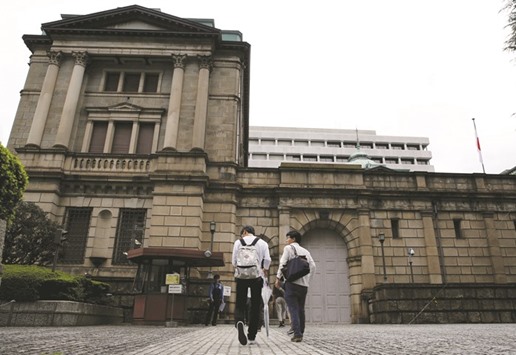The Bank of Japan (BoJ) is caught in a quandary. To let bond yields rise or not.
Governor Haruhiko Kuroda wants to make longer-maturity debt more attractive by letting yields move higher, yet doing so will put pressure on his efforts to keep 10-year borrowing costs close to zero. He will eventually have to raise the target rate, say fund managers including Sumitomo Mitsui Asset Management Co, AllianceBernstein Japan, MassMutual Life Insurance and Daiwa SB Investments.
“As the BoJ gets closer to achieving its inflation target, it will face the need to either change the 10-year target or expand the range,” said Jun Fukashiro, a senior fund manager at Sumitomo Mitsui Asset Management in Tokyo.
The question is whether the central bank can get away with saying that benchmark debt yielding 0.3% to 0.4% is still around zero, he said.
The intensified debate over Japan’s bond market, once anchored by the BoJ’s commitment to hold borrowing costs down, comes as inflation quickens for the first time since 2015. With hedging costs rising and political uncertainty in Europe, Japanese fund managers are also mulling bringing money home. A crucial factor in that decision will be the level of long-term yields they can get.
Yields on 30-year debt are hovering below 0.9% due to the central bank’s debt purchases and the negative interest-rate policy introduced in January 2016. Nippon Life Insurance Co president Yoshinobu Tsutsui said in January the company would need to see 20- and 30-year bond yields rise above 1% before it would consider buying.
For that to happen, the 10-year yield will need to move higher.
“There is more scope for super-long JGB yields to rise as life insurers show little appetite until these yields exceed 1%,” said Masahiko Loo, a fixed-income portfolio manager in Tokyo at AllianceBernstein, which oversees about $490bn. “A further rise in these yields might spark investor buying as insurers have abundant cash on hand.”
The March bond-purchase plan released by the BoJ on February 28 suggested the central bank is letting the curve steepen as it gave itself the flexibility to buy fewer of its longest maturity debt.
The BoJ followed through on Friday by trimming purchases of bonds maturing in more than 25 years to ¥100.3bn ($881mn) from ¥120.4bn at a previous operation on February 24.
The central bank cut purchases of this basket by 3% in February compared with September, when it shifted to a policy of yield curve control.
Not that the BoJ has a lot of options.
The Japanese central bank’s policy of capping borrowing costs has come under increasing pressure as stronger US economic growth and signs of inflation globally have pushed up bond yields around the world.
Federal Reserve Chair Janet Yellen said on Friday an interest rate increase in March will likely be appropriate if policy makers decide that growth data support expectations.
“The BoJ is likely to tolerate some degree of increase in super-long yields provided they stabilise at levels they deem as appropriate,” said Shinji Kunibe, general manager and head of a fixed-income management department at Daiwa SB Investments in Tokyo. “When global yields rise further in the future, the BoJ may seek wider deviations through a dialogue with markets, something like a range of about 20 basis points plus and minus zero.”
Inflation in Japan is also picking up, which is putting more pressure on long-term yields to rise. Data published on Friday showed consumer prices excluding fresh food increased 0.1% in January from a year earlier, the first gain since December 2015.
Still the BoJ has not yet shown it is willing to loosen its grip on the 10-year yield. After the yield jumped to 0.15% on February 3, the highest level in 12 months, the BoJ offered to buy an unlimited amount at a fixed rate to drive it back down. It was at 0.075% yesterday.
While the operation was a success, it added to the uncertainty in the minds of fund managers.
“I think the BoJ wouldn’t mind steepening the curve to offset the minus impact from the negative rate, by pulling the yield levels to where insurers can buy,” said Satoshi Shimamura, head of rates and markets for the investment strategy department at MassMutual Life Insurance. “For that, the BoJ will probably raise the 10-year rate target at some point.”

Men walk towards the Bank of Japan building in Tokyo. The Japanese central bank’s policy of capping borrowing costs has come under increasing pressure as stronger US economic growth and signs of inflation globally have pushed up bond yields around the world.
